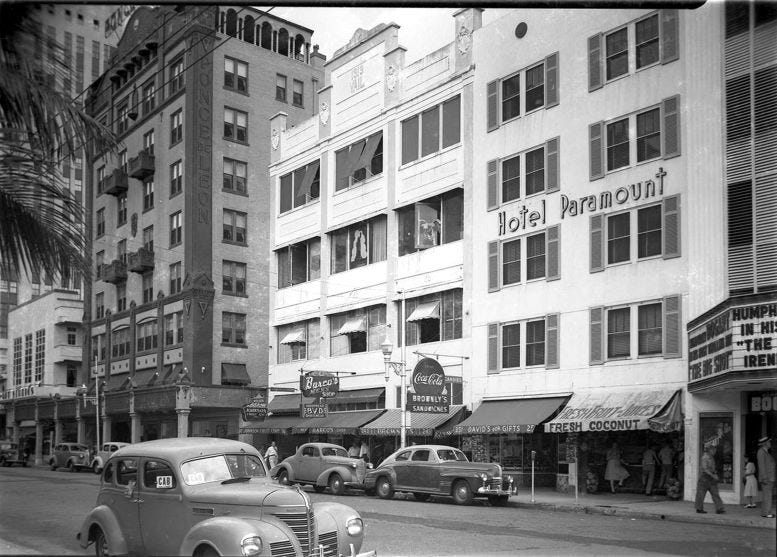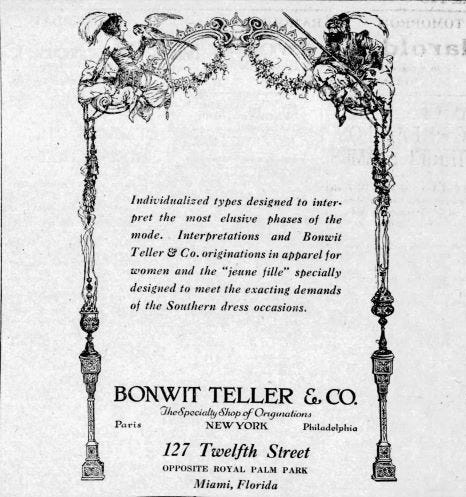Sloppy Joes on Flagler Street
The story of a quirky hole-in-the-wall juice stand that operated out of the Paramount building at 267 East Flagler Street for 33-years. This is the story of Sloppy Joes.

While not as famous as its namesake in Key West, a lively restaurant and bar best known for its annual Ernest Hemingway look-alike contest, Sloppy Joe’s in Miami carved out its own niche as a beloved, no-frills juice bar on Flagler Street. For over thirty years, this modest spot at 267 East Flagler Street in the Paramount Building evolved from a simple stand-up juice counter into a quirky local institution, known as much for its colorful staff and patrons as for its fresh juices.
The narrow storefront that housed Sloppy Joe’s beginning in 1942 had a varied past. Before the juice bar took root, the space had hosted an eclectic mix of businesses, including a clothing boutique, several real estate offices, two shoe stores, and a sandwich shop. What follows is the story of Miami’s historic Sloppy Joe’s juice bar and the unique space it called home for more than three decades.
Fairfax Building
The Fairfax Building was developed by the Ralston Brothers, key figures in shaping Miami’s early skyline during the city’s rapid growth leading up to the 1920s building boom. Among their contributions were the Ralston Building at 62 NE First Avenue, Miami’s tallest structure at eight stories when it was completed in 1917, Calumet Building at the northwest corner of NE Third Avenue and Flagler Street, and the Fairfax Court Apartments, located next to the YMCA on NE Third Avenue.
Facing Flagler Street just west of the Calumet Building, the Fairfax opened in January 1920 as a modern apartment building. Advertised as offering some of the most luxurious accommodations in the city, the management company had hoped it would quickly lease the entire building. However, just a year after its opening, the building underwent a transformation from an apartment complex to a hotel which featured a theater. By the mid-1920s, the Paramount Corporation would take over the management of the building, including the theater and hotel. In 1931, the name of the cinema changed from the Fairfax to the Paramount Theater, with the hotel adopting the same name a few years later.
Alongside the theater and hotel, the building, soon known simply as the Paramount, featured several ground-floor retail spaces. One of these was occupied by a prominent New York-based women’s clothing boutique which operated out of 267 East Flagler Street from the buildings debut in 1920 until the mid-1920s.
Bonwit Teller Fashion Boutique (1920 – 25)
Bonwit Teller & Company was a women’s boutique department store established in New York City on Fifth Avenue. After expanding to Paris and then Philadelphia, the boutique retailer opened a location at 267 East Flagler Street in downtown Miami. They actually operated out of a temporary building across from Royal Palm Park and moved to the Fairfax when the Calumet building was constructed in the early 1920s.
Bonwit Teller operated out of the Fairfax building from 1920, when it opened, until 1925, when they moved to a larger location at 824 – 28 Lincoln Road on Miami Beach. They would also expand to Palm Beach around the same time. Once the boutique retailer left 267 East Flagler Street, the commercial space changed directions and became office space for real estate organizations during the height of the building boom of the 1920s.
Keep reading with a 7-day free trial
Subscribe to Miami History to keep reading this post and get 7 days of free access to the full post archives.




